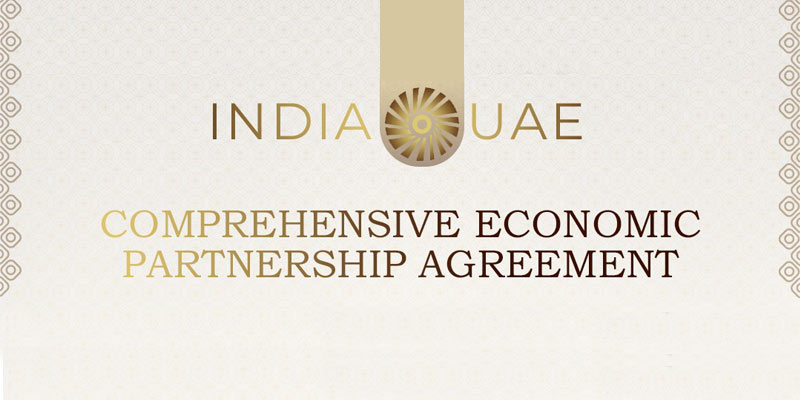- India
- Mar 29
India-UAE CEPA to come into force from May 1
• The Comprehensive Economic Partnership Agreement (CEPA) signed between India and the United Arab Emirates (UAE) will come into force from May 1, Commerce and industry Minister Piyush Goyal said.
• The CEPA was signed by India and the UAE in February, which aims to boost bilateral trade to $100 billion in the next five years from current $60 billion.
• Under the pact, domestic exporters of as many as 6,090 goods from sectors like textiles, agriculture, dry fruits, gem and jewellery would get duty-free access to the UAE market.
• India is looking at increasing exports in goods and services to $2 trillion and the UAE would play a key role in achieving that target.
• The UAE is a door for tapping other markets from Europe and Africa.
The objectives of CEPA:
i) Strengthen and enhance trade and economic cooperation in the fields agreed between the Parties.
ii) Liberalise and facilitate trade between the Parties in accordance with the provisions of this Agreement.
iii) Enhance investment facilitation and cooperation between the Parties in accordance with the provisions of this Agreement.
iv) Improve the efficiency and competitiveness of the Parties’ manufacturing and services sectors and to expand trade between the Parties, including joint exploitation of commercial and economic opportunities in non-Parties.
v) Facilitate and enhance regional economic cooperation and integration.
vi) Build upon the Parties’ commitments at the WTO.
Key points of the agreement:
• The agreement will provide significant benefits to Indian and UAE businesses, including enhanced market access and reduced tariffs.
• The CEPA covers trade in goods, rules of origin, trade in services, technical barriers to trade, dispute settlement, telecom, customs procedures, pharmaceutical, digital trade and cooperation in other areas.
• CEPA is expected to help in unlocking new trade routes between Africa and Asia.
• It would generate 10 lakh jobs across multiple labour-intensive sectors.
• The pact will ensure substantial net gains for India, particularly in industries such as gems and jewellery, textiles, leather, footwear, sports goods, plastics, furniture, agricultural, engineering products, medical devices, and automobiles.
• About 90 per cent of the Indian exports, in terms of value, to the UAE will get market access at zero duty from day one of the entry into force of the agreement.
• Zero duty will be applicable within five to 10 years on an additional 9 per cent of the trade value for products such as electronic goods, chemicals and petrochemicals, articles of stone, cement, ceramics and machinery.
• For the first time in a trade agreement, a separate annexe on pharmaceuticals has been incorporated to facilitate access to Indian pharmaceutical products.
• CEPA is likely to benefit about $26 billion worth of Indian products that are currently subjected to five per cent import duty by the UAE.
• In the services sector, the UAE has offered 111 sub-sectors to India as compared to 100 sub-sectors by India to the UAE.
• Substantial gains in India’s areas of interest include computer-related services, audio-visual services, educational services, health services, tourism and travel-related services and professional services (nursing, engineering, accountancy etc).
• The CEPA will also provide a platform for SMEs in both countries to expand internationally by granting them access to new customers, networks, and avenues of collaboration.
CEPA with other countries
• CEPA between India and South Korea was signed in August 2009 which came into force from January 1, 2010. The two sides have commenced negotiations for the upgradation of CEPA.
• CEPA between India and Japan was signed in February 2011 which came into force in August 2011. India has requested Japan to initiate the process of review of the Agreement to ascertain mutual gain to both the countries.
• India and Bangladesh are engaged in strengthening the trade relations by exploring prospects of entering into a bilateral CEPA covering goods, services and investment.
• In 2010, Canada and India launched negotiations toward a Comprehensive Economic Partnership Agreement (CEPA). So far, 10 rounds of negotiations have been held, with the last round held in New Delhi in August 2017 followed by an inter-session meeting held in February 2018.
Manorama Yearbook app is now available on Google Play Store and iOS App Store

